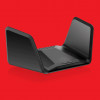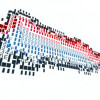Soon Your Desk Will Be a Computer Too

In the early 1990s, Xerox Parc researchers showed off a futuristic concept they called the Digital Desk. It looked like any other metal workstation, aside from the unusual setup that hovered overhead. Two video cameras hung from a rig above the desk, capturing the every movement of the person sitting at it. Next to the cameras, a projector cast the glowing screen of a computer onto the furniture’s surface.
Using Xerox’s desk, people could do crazy things like highlight paragraphs of text on a book and drag the words onto an electronic word document. Filing expenses was as easy as touching a stylus to a receipt and dragging the numbers into a digital spreadsheet. Suddenly, the lines between the physical world and digital one were blurred. People no longer needed a keyboard, mouse, and screen to harness a computer’s power; all they had to do was sit down and the computer would appear in front of them.
Despite its novelty—or maybe because of it—the Digital Desk never took off. Technology moved in the opposite direction; towards the glassy, self-contained boxes of smartphones, tablets, and laptops. But researchers never gave up on the vision, and now more than 35 years later, these half-digital, half-physical workspaces might actually make sense.









































































